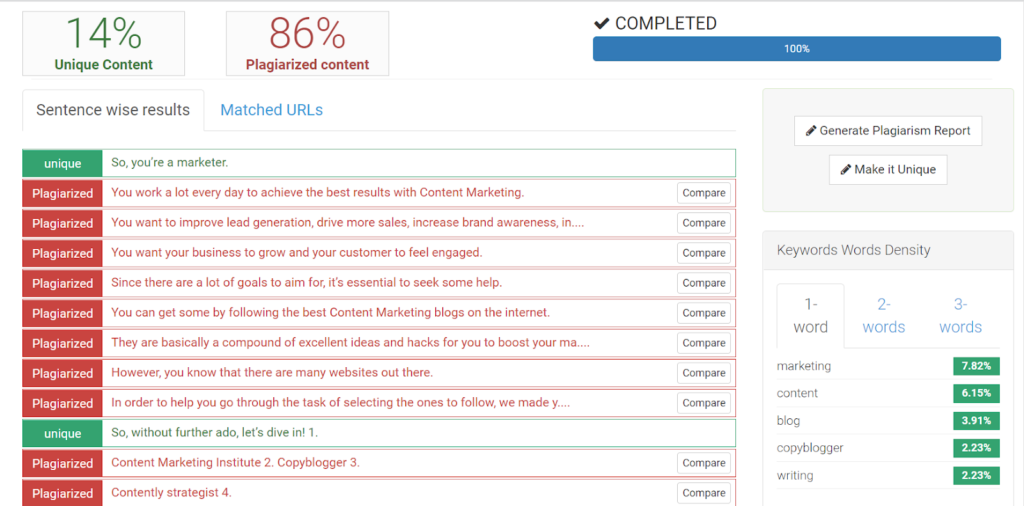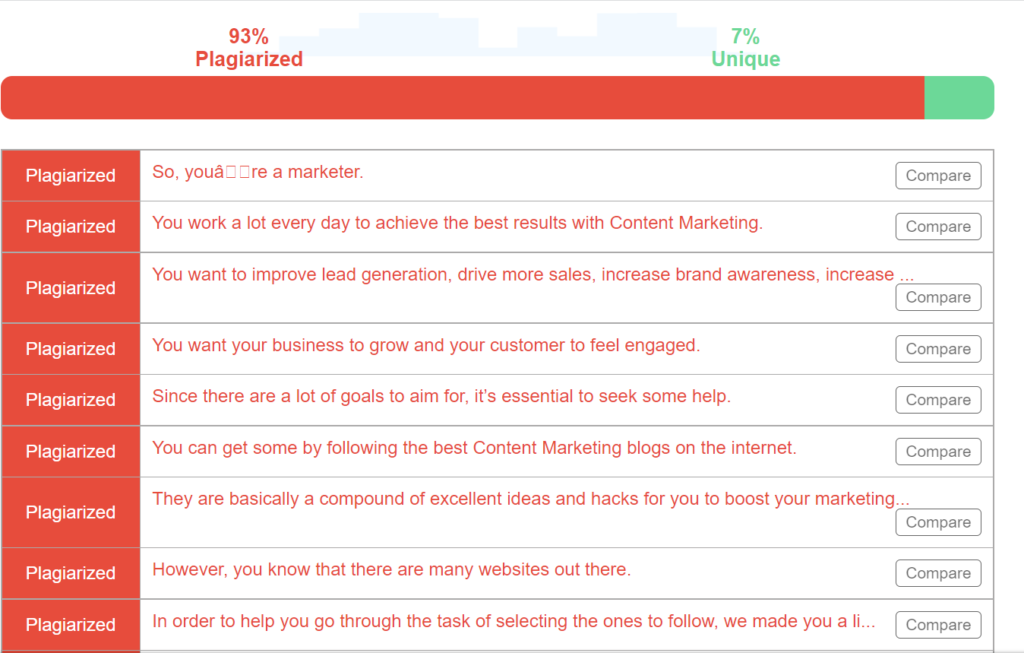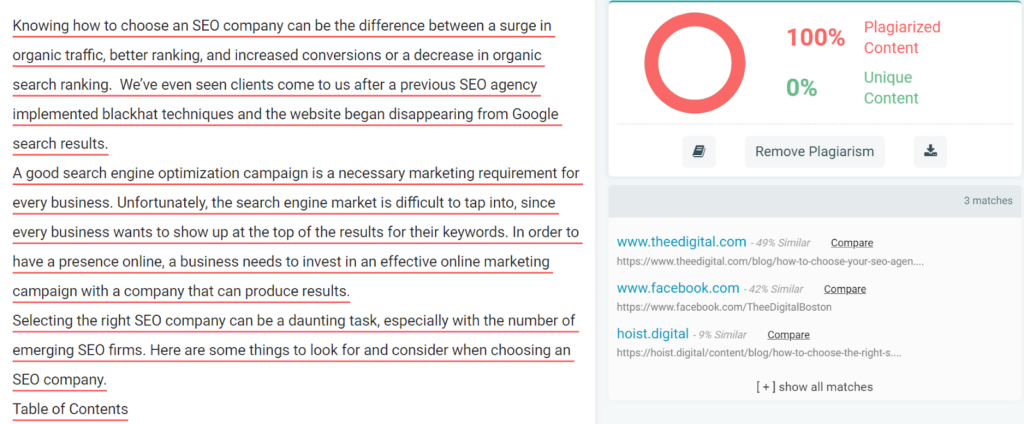Are your blog posts and articles coming up with large percentages of plagiarism? Can’t figure out how to create 100% unique content?
In every writing, research is done. You came across many sources from which you copied data during the study. You can make your arguments strong by copying data, but it has a significant drawback. By copying data, you can be accused of plagiarism. . If you are not familiar with plagiarism, let’s glance at it.
What is plagiarism?
Plagiarism is the unauthorized use of someone’s work or stealing someone’s research without crediting him. Plagiarism is done by students in their assignment and thesis formulation. But it can also be seen at a business level where a person can copy someone’s plan.
How to deal with plagiarism?
Before moving to a solution, it is essential to find out the plagiarism. Depending on your style, there can be different percentages of plagiarism in your writing. So, to eliminate plagiarism, it is crucial to find out the percentage and type of plagiarism in the content. Based on the measure, you can adopt the relevant solution to it.
How to check plagiarism?
To check plagiarism, there are online tools. These tools have different features and types, and you can use them to prevent plagiarism. This tool can be free or can charge some amount for its services. These tools are used for checking plagiarism and can also be used to eliminate plagiarism.
Don’t worry!
In this post, we are going to go over 10 tips that you can follow to make sure that your blog content is totally plagiarism-free. Yep, we’ll guide you about more than just using a plagiarism checker.
Don’t get us wrong. Using a tool to check plagiarism is very important. But it’s not the end-all and be-all of creating unique content.
Without further ado, let’s get right to the 10 tips that you can follow to come up with plagiarism-free posts and articles for your blog.
1. Come Up with a Unique Title

First things first, and that is creating a unique title.
The logic and ‘wisdom’ behind creating a unique title is that if your title is unique, your content will automatically be unique as well.
On the other hand, if you nick the title from an existing source and just change a couple of words in there, you will invariably and unintentionally start talking about the same things as the original source…and that is pretty much a stepping stone to plagiarism.
Take an example. Let’s say I wanted to write about laptops in 2022, and I decide to pick a topic from a source that reads ‘Best Budget Laptops for Programmers and Web Developers in 2022’.
I could modify it a bit and make it like this ‘Best Laptops for Programmers and Web Developers Under $500’.
Now, since the theme of this title is the same as the original, I could start talking about things like what is the normal budget for a laptop and what sort of specs are good for programmers and developers.
And incidentally, these could be the same things that the original author could be talking about in their article.
Got the point?
Apart from the dimension of uniqueness, creating an original title is generally listed as a content creation strategy by experts since it is a great way to create interest in the readers.
2. Do Proper Research

Once you’re done picking a title for your blog, you need to put the pen and paper aside and get started with the research. (Okay, no one uses a pen and paper to write a blog post, but let’s stick to the expression.)
Doing proper research is a vital step in coming up with unique content. When you do your research from multiple sources, and you accumulate a proper supply of useful data to feature in your article, you drastically reduce your chances of plagiarizing content.
Here’s why.
A shortcut method of doing ‘research’ for writing blog posts is to just read an online article related to your topic, and then start writing based on the few ideas and concepts that you may have gleaned from it.
This is a terrible way of gathering material for writing a blog post. In doing this, there is a high probability of duplicating the content written on the original source.
And even if your work is technically free from plagiarism, your readers may still be able to recognize the copy-job, and that can damage your reputation and integrity.
But when you have a lot of information to write about and expound on, you will be able to create wholly unique content without any problems.
3. Create a Distinctive Outline
After the research is done, you need to move on to creating an outline.
During the research phase, you would probably have visited a lot of different websites and articles to get all your information. This would basically mean that you will have a good idea about what sort of topics and headings the other sources have featured in their content.
When creating an outline, you should try and steer clear of any generic and cliché topics or ideas that the other sources have already written on. This will further help you avoid plagiarism in your content and make it as unique as possible.
A common mistake that writers can make here is to just search their topic on the internet, and then pick the first result from the SERPs. Thereafter, they take all the ideas from that one source and shuffle the headings around to make it look different.
This is not at all recommended. Readers can easily spot if a post or article matches the content from the first-ranking website.
4. Make and Use Your Own Style

Every writer has his or her own style. The style of a writer is usually defined by the tone they take in their content. Some writers are humorous, and they add quite a bit of informal phrases and sentences throughout their content.
Others are serious and straightforward, and their content stays strictly relevant to the topic at hand.
Whenever you want to write a post, try and come up with your own style by choosing specific bucket brigades and transitional expressions.
While we are on it, let’s discuss bucket brigades a little.
Nothing shows a writer’s personality and persona more than the type of bucket brigades they use.
For example, one writer could use the phrase ‘Here’s the thing’ or ‘Here’s the deal’ a lot in their content. Another writer could, on the other hand, use the phrases ‘Let’s digress a little to explain that’ or ‘before moving on, let’s do this or that.
The former writer would, due to the choice of bucket brigades, come off as frank and casual whereas the latter may sound a little stiff and formal.
The main point that you should take away from this part is that when writing any type of content, don’t copy or imitate the style of your source. Don’t use their crutch words, transition phrases, or bucket brigades. Try and use some different ones instead.
5. Insert Citations Where Needed
If plagiarism is poison, then citations are the antidote.
There are some things (more of which we will discuss further on) that nullify plagiarism. Citations are one of them.
If you have to take some material from an existing source in such a way that the original words cannot be altered much, you can use citations and references in order to give the actual author their due credit.
That way, the copied content in your text will not be recognized as plagiarism, and your content will stay unique.
It should be noted that citations are not used in isolation. Citations refer to the bracketed words that appear in between the text…kind of like this: (Wierdo, 2022).
Citations are corroborated by detailed references which are given at the end of the content.
These are usually found in research papers or assignments but they can be used elsewhere as well.
6. Add Hyperlinks
Like citations, hyperlinks are also used for accrediting a source or author.
Citations and references are suitable for content in which a lot of material has to be attributed to a source. In other words, they are suitable for content in which a lot of stuff is taken from another source.
But, if you’ve only taken one or two facts and figures in, say, a blog post of 1,000 words, then you can just use a hyperlink instead of going through the trouble of generating and inserting citations.
You can either mention the source by name or then add a link…like this:
According to dumb-dumb.com, potatoes are green.
Or, you can mention the source using a general word, and then add a hyperlink…like this:
According to a buffoon website, potatoes are green.
7. Use Quotes
Quotes have the same purpose and application as hyperlinks.
However, in some situations, adding a backlink may not be viable. For example, you may have added a ton of links already, and adding more could make the content look strange. Or, you may be submitting some content to a person who could have set a limit to the number of outbound links…as is the case with guest posting.
In these types of cases, you can use quotes instead.
The quotes are simple. You just need to wrap the copied sentence in a couple of quotation marks (“”) and then write the name of the source/author. It kind of looks like this:
“Light travels faster than sound. This is why some people appear bright until you hear them speak.”
– Albert Einstein
8. Use Plagiarism Checkers
The sad truth about content uniqueness is that even after taking all the necessary steps (like proper researching, creating your own style, quoting, and whatnot), some percentage of plagiarism can still sneak inside.
There is a lot of content online. According to a source, more than 6 million blog posts are published daily. Even if we presume every blog post to contain just 5 words, that adds up to 30 million words being published daily on blogging sites.
Yeesh.
Creating unique content online is like walking in a minefield…especially if you are working on a popular niche.
The point of all this is that once you are done writing your content, you shouldn’t just finalize it thinking that since you didn’t copy anything deliberately, there’s not going to be any plagiarism in it.
You should always run your draft through a plagiarism checker before publishing it.
9. Paraphrase Where Necessary
Okay, checking for plagiarism is good and all, but what do you do if the percentage comes back with just 80% or 85% uniqueness?
True, you could use quotes, citations, and hyperlinks, but these techniques aren’t very feasible for large chunks of content.
In this type of situation, paraphrasing is a good method to use.
Paraphrasing is defined as the process in which a piece of content is written in such a way that the words and phrases used in it are changed, but the main idea and context remain the same.

For example, if we paraphrase this sentence:
The man drove his car into the pole thinking it to be a hallucination.
…it would become something like this:
The person rammed his vehicle into the post imagining it to be an illusion.
See? Same meaning, different words.
You can either paraphrase your content yourself, or you can use an online tool to do it instead. The latter is a good recourse for long-form content whereas the former is recommended for shorter stuff.
Before wrapping this point up, we should mention that although paraphrasing will save your content from appearing as plagiarized, it is not something that you should make a habit of nor is it something that you should rely on to create the content in the first place.
In other words, paraphrasing should only be done in situations where your own content is showing up as plagiarized and you need to reword it to make it unique.
Some people paraphrase whole articles and posts, and then later pass them off as their own. This sort of action is totally unbecoming of a writer, and it should not be done in any case or scenario.
10. Create and Use Original Images and Graphics
And last but not least, be sure to create and add unique images and visuals to your content.
Adding existing images does not really count as plagiarism as far as the technicality goes. True, you can get in trouble if you use a licensed image without the permission of the original poster but that is another matter.
However, the reason why we advise adding unique graphics to your content is that they help to make your material look distinguished and one-of-a-kind.
If you were to add existing images by taking them from a source, it would slightly diminish the overall integrity of your content.
But if you were to add images that were solely featured in your content and nowhere else, it would create a distinct and ‘exclusive’ impression.
Bonus: Top 4 plagiarism checkers for Business writing
Plagiarism checkers, also called plagiarism detectors, are used to find out the percentage of plagiarism in your content. Different tools have different working methodology and operations. You can find out a long list of plagiarism checkers on the internet. Out of all these checkers, the four best tools that can help you to diagnose plagiarism are as follows:
1. Check-plagiarism.com

Check-plagiarism is the most efficient and easy tool that can be used to detect plagiarism, and it is widely accepted by students, teachers, and professional writers.
How can you use this tool?
To use this tool, follow the following steps:
- Upload your file from the Select file option.
- You can copy your text on the Insert your reader here slot. If you do not have text, you can directly add the URL by its advanced option.
- After adding text or file, you have to verify the reCAPTCHA.
- After verification, hit on the Check plagiarism option.
- Results will appear on screen in seconds.
What is unique in it?
This tool is unique due to its multi-functionality.
- You can check up to 2000 words per submission in its free version.
- In its premium setting, you do not have any word limit.
- It is very responsive and fast. No matter how big your file or text is? It will check in a few seconds.
- It is very safe to use. It does not save any file in its database or allow someone to access it.
- It is effortless to use, and it gives clear instructions about everything.
- You can check up to 5 files at a time.
- It is compatible with different file formats such as PDF, Doc, etc.
- It is not only a plagiarism checker, and you can also use it as a rewriter and paraphraser.
- It also says a word and character count.
2. Editpad.org

Edit pad is a fundamental tool for plagiarism checking. It is mostly; used by students.
How can you use this tool?
- Upload your file or copy the text on the input slot.
- Then select the langue in which you want to plagiarism.
- Verify the reCAPTCHA.
- Click on the Check plagiarism option, and results will appear.
What is unique in it?
- It tells you about plagiarism and unique content percentage.
- It is for multiple languages.
- It is easy and understandable.
- This tool supports different file formats like DOCX, TXT, PDF, etc.
- It also provides a list of sources that are used in copy-pasting.
- Its free version gives a 1000-word limit.
- It is a bundled tool and provides the service of a paraphraser and grammar checker.
3. Prepostseo.com

It is an advanced tool used mainly by professionals for plagiarism detection, and it is a famous tool among web admins and professional content creators.
How can you use this tool?
- Copy-paste your text, upload a file or add the URL of the source.
- Select language.
- Verify reCAPTCHA.
- Click Check plagiarism.
What is unique in it?
- It gives a list of matched sources along with the percentage of plagiarism.
- It supports URL checking
- It also gives word count and readability.
- It provides you with a deep search from many internet sources.
- It offers a chrome extension to make itself accessible.
- It supports multiple languages and accepts different file formats.
- You can also download its android and iOS apps.
- Through its Make it unique option, you can remove all the plagiarism.
- It is fast and secure.
4. Rephrase.info

This plagiarism detector is also a good choice if you want an easy and quick check. Just like other tools, it has a free and paid version. Instructions are also given for its usage.
How can you use this tool?
- Copy-paste your text, upload a file or add the URL of the source.
- Select language.
- Verify reCAPTCHA.
- Click Check plagiarism.
What is unique in it?
- It has a vast database from which it searches for even a single word of plagiarism.
- It is rapid in generating plagiarism reports.
- Tools are supportive for multiple languages.
- This tool is based on advanced AI technology.
- It highlights plagiarism in red and unique in green color.
- You can also check grammatical and punctuation mistakes through it.
- This checker is also a good text rewriter.
Plagiarism is a crime. It can harm your career and content value. For the removal of it, the first step is its detection.
Different kinds of plagiarism detectors are used to determine the percentage of copied material. Every tool is unique on its own.
Depending upon the best feature, four tools are discussed. Everyone can use them. These tools will help you to find out plagiarism so that by removing it, you can make your content SEO optimized and unique.
Conclusion
In this post, we looked at 10 tips that you can follow to create unique content. Let’s do a quick recap for each before wrapping this post up.
First off, you need to make sure that you come up with a unique title. Unique titles are conducive to unique content. You can try using ideas generating tools to get some help.
Do proper research. You will have more material to cover and you’ll be less likely to copy something from a specific source.
Make sure that your outline is unique. If you take the outline from a previously published post or article, you will start to copy them unintentionally.
Create your own crutch words and bucket brigades to make your writing style distinctive. Don’t copy the tone of any existing source.
Use citations to cite the original author where needed. Similarly, you can use hyperlinks to give a link to an online source in order to accredit it.
You can also use quotation marks to indicate that a particular sentence, phrase, or paragraph is copied from a book, article, etc.
By using plagiarism checkers, you will be able to spot any accidental plagiarism in your content. You can paraphrase the duplicated parts to make it unique.
And last but not least, you should add unique visuals to your content to make it stand out from the rest.